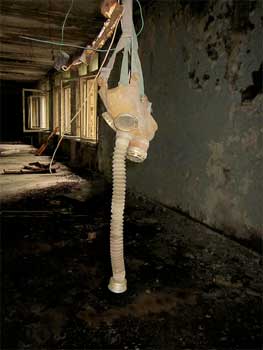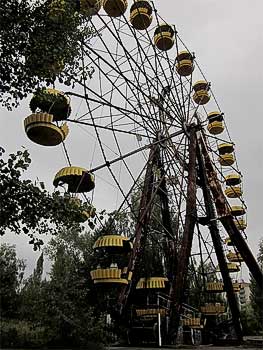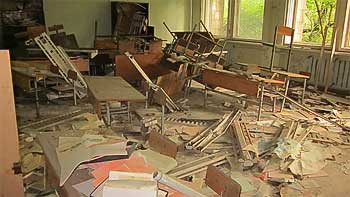A Writer Writes: Chernobyl by Ashley Hardaway (Ukraine 2006-08)
Ashley Hardaway (Ukraine 2006–08) has never been able to sit still. It progressively got worse. Far away universities. Backpacking trips. Solo vacations. It wasn’t any big shock when she announced she was joining the Peace Corps – leaving for Ukraine a month after graduating from college.
Afterwards, upon moving back to America, Ashley would continuously find herself saying “In Ukraine this one time…” To everyone’s great delight and/or horror she got a publishing deal for a travel guide to Ukraine — Ukraine: Discover the Real Ukraine . Traveling around the county again and writing about it would either rid her of all her thoughts regarding this country, or provide her with even more stories to torment people with at Christmas time.
. Traveling around the county again and writing about it would either rid her of all her thoughts regarding this country, or provide her with even more stories to torment people with at Christmas time.
So far, all signs point to the latter.
Ashley Hardaway now lives in Florida where she continues to write – about other things besides Ukraine.
However, for our site, she wrote a piece on Cherobyl. As we all know, on Saturday, April 26, 1986, reactor number four of the Chernobyl plant underwent a systems test. During this routine test a sudden output surge occurred and an emergency shutdown was attempted. This caused a series of explosions which soon ignited. This fire sent a plume of radioactive smoke fallout up into the atmosphere and cascading over the area, including Prypiat, and went further into the western Soviet Union and Europe. 60% landed in Belarus. A level 7 on the International Nuclear Event Scale it remains the worst nuclear power plant accident in history. Now the city of Prypiat lies in abandon and a 19-mile radius “exclusion zone” has been established where catastrophic radiation contamination remains.
Naturally, Ashley, decided to visit the site and here is her story.
•

Dark Tourism Comes to Ukraine: Chernobyl
THE CAMERA’S WERE ALREADY STARTING to go off – click, click, click – as we passed through the first checkpoint. Barely in the 30 KM zone Chernobyl, so far, resembled any former large soviet-town after the fall of the empire: deserted buildings, tress growing up through the concrete, a few men smoking on the sidewalks. My camera remained in my lap. The guy next to me asked if I was saving my batteries. “I don’t want to say this, because it might come off as snide,” I said, “but this all looks remarkably similar to the Ukrainian village I used to live in.” Since we had spent the two hour bus ride here exchanging life stories, the way people seemingly only do with complete stranger, he knew my background – Peace Corps volunteer in Ukraine turned travel writer – “Ah yes,” he quipped, “already a pro”
I smirked as the bus pulled into the final checkpoint. We exited and presented the surly guard with our passport which he checked against his official documents. Taking a tour of Chernobyl – you can only go by tour or private escort – is absurdly expensive. Part of the reason they can charge so much is the fact that you have to get permission to enter and civilians by themselves cannot gain it. When I told my Ukrainian friend, Natasha, where I was going, and more importantly how much it cost, she replied with what would translate to: “why in the hell would you pay so much to go there?” The irony of the situation caught me off guard at that moment: People couldn’t escape here fast enough and now here come the Western tourists paying to get in.
After being cleared, we got back in the bus and made the short drive into Chernobyl’s center. Like most soviet work towns this one was clustered around a main city-center which had a cafe, movie-theatre, post-office, bank and park: some of which still seemed to be operational. Chernobyl, much to the contrary belief, is still an active area with many people working within it every day. Most commute in daily, but some residents have taken up housing on the outskirts of town. They are mostly elderly citizens (children cannot live within the perimeters) who left and returned when the government allowed them to again. When the group scoffed at the notion the concerned bus driver told us “they have no family elsewhere. Or money. This is their home. They are old. Why would they leave?”
The bus stopped and we were escorted into a two story, wooden office building. Inside photos of the town, maps of the radiation levels and outlines of the blocked-out zones covered the walls. Our guide, Igor, pointed to a map in the far corner that looked like a paint ball had been pelted against it – smatterings of red going out in every direction. The red markings, he explained, showed the different radiation levels throughout the city. Some parts were heavily effected, but twenty feet away it was possible to find stretches where there was virtually no radiation remaining at all. He explained that the people working in Chernobyl carefully heed this guide and work only within “the safe” perimeters.
Igor, who wore thick military boots that he threw away monthly, then handed out the infamous Geiger counters. Immediately the group began regarding them with infinite interest, mildly gasping with every click that registered a higher number. Now it was a measly 0.12. I wasn’t nervous before, but looking out the window of the office, towards the bombed out edifice of reactor #4, I began to wonder if I was doing something incredibly stupid. “Think of your future children!” Natasha had warned. Igor reassured us that the amount of radiation we were going to be exposed to would be the same as one would experience on a transatlantic flight. He added; “plus, you go through at detector at the end of the tour that will tell you if you are clean or not.” When asked if anyone had ever set if off, he chuckled and rattled off a line reminiscent of a carnie at a fairground horror ride trying to scare the children: “Only one. A Dutch photographer who wandered off the path and stood on the moss for too long-” The moss being like a radioactive sponge. In my mind I finished his sentence with and we never saw him again.
Later we began the journey to what I suppose is the morbid “highlight” of Chernobyl: the town of Pripyat. The Geiger counters started clicking up: 0.17, .022, 0.23, on the drive there, creating a cacophony of mad beeps throughout the tiny bus. We stopped to take in an overgrown field where the skeletons of abandoned Soviet tanks could be seen through the brush. Having been exposed to immense radiation they couldn’t be moved or recycled, so here they laid for I suppose the rest of eternity. A sign on their frame warned against touching them, but some of the group – having that brash arrogance that seems inherent to international backpackers – disregarded the caution and leaned up against them for a photo-op anyways. Igor moaned as he slammed his boots on the sidewalk; attempting to get some of the soil off of them. He went to say something, but lit a cigarette instead.
Reactor #4 is so large it practically eclipses the horizon. Coming up upon it, it looms like a post-apocalyptic behemoth, all concrete and collapsing steel. Construction had already begun on the building’s sarcophagus, which aims to seal off what radiation remains by constricting it like one of Houdini’s straight jackets and hoping for the best.
We parked across from the reactor, a place that at one time would have given us a view of the river that once flowed through here. But that too had been patched up; dammed off so that the water wouldn’t contaminate nearby water sources.
The group was already starting to switch “on” their photography gear when Igor instructed that we could take pictures facing the Reactor only and not in the other direction – a gated off factory of sorts. “They are watching us,” he whispered. An attempt at dry humor? Occasionally beat-up trucks would drive past us and up to the gates of the factory where men in Hazmat awaited them.
This somewhat eerie sight was undercut by the sound of a leaf blower. Looking to my right I saw a young guy, in civilian clothes, jamming to a disk man while cleaning up the streets. He stopped to gawk at the group which was rotating having their pictures taken in front of the bombed-out edifice. I’d like to say that I was above the whole scenario and scoffed at having my picture taken: but I did. Click. Officially a tourist.
The bus continued driving to the “Red Forest” where the trees are unnaturally eerie shades due to the tremendous radiation they were exposed to. Coming up upon them the Geiger meters started beeping wildly: 0.70, 0.97, 1.14, 3.23,  8.12. At one point you couldn’t hear Igor speak over the violent warning clicks. Igor stopped the bus and jumped out, his thick boots hitting the highly contaminated moss. He held up his Geiger counter and it flashed 11,000, beeping like mad. The only other girl in the group clicked a photo and asked him to smile. Igor snapped “I will not smile here. This is not a happy place.” She sheepishly apologized and we carried on.
8.12. At one point you couldn’t hear Igor speak over the violent warning clicks. Igor stopped the bus and jumped out, his thick boots hitting the highly contaminated moss. He held up his Geiger counter and it flashed 11,000, beeping like mad. The only other girl in the group clicked a photo and asked him to smile. Igor snapped “I will not smile here. This is not a happy place.” She sheepishly apologized and we carried on.
The sign for Prypiat is oddly merry, making me think how great a place this would have been to live in its heyday. With a school, gymnasium, hotel, restaurants, and even a small amusement park for the kids — this town would have been special in any country; Let alone Ukraine where most villages are thankful if they have 24hr running water. The pride of the Soviet Union, Pripyat was shown off to foreign leaders and international dignitaries as the example of how great communistic forms of industrialization could be.
Now before me it was nothing but deserted piles of ruble and rusted reminders of the lives that were led here. Walking into the center suddenly became an obstacle course: all uprooted trees, collapsed walls and dried up fountains. Glass was everywhere. Every window in every building of the central square had been broken out in an attempt to aerate them and now glass made up the city’s foundation. The ever-present crunch of it shattering below feet was all that could be heard.
The city’s House of Culture loomed in the distance, lending the grey horizon its foreboding centerpiece. Walking into it felt like entering a doomsday movie soundstage: faded murals of soviet glory and deteriorating flags clung to the walls. Rainwater cascaded through the holes in the ceiling and puddles accumulated in glassware that looked like someone had been drinking out of it when the explosion happened, only to be dropped and never touched again. People in my small group began clicking away, crouching lower to get a better shot. A few rearranged things for a better angle only to be told “Do not touch anything! It’s not good…” but they didn’t seem to care (click).
We walked under the overhanging trees, the leaves of which we are warned to avoid, to the school where the second floor library contents seemed to have exploded throughout the building.  Books, many of which were probably the last print, were everywhere. School desks were overturned and on some chalkboards you could still make out the faint outlines of that last day’s lesson. In the third floor hallway a gas mask hung from one of the collapsed support beams. No doubt planted here as a photo-op prop; it still made for an eerie-slight.
Books, many of which were probably the last print, were everywhere. School desks were overturned and on some chalkboards you could still make out the faint outlines of that last day’s lesson. In the third floor hallway a gas mask hung from one of the collapsed support beams. No doubt planted here as a photo-op prop; it still made for an eerie-slight.
The Theme Park, where the now excessively symbolic Ferris-wheel lingers, is behind the school. Scheduled to open the day of the accident, the park is now nothing more than weed eclipsed metal objects. “You can do anything but sit on the rides,” Igor tells us. Immediately the group scatters like children in some sort of zombie-themed amusement park. Strange to be in a place where it looks like the world has ended and hear laughter.
In a cafe on the outskirts we are served a large meal “all of which was imported from outside the region.” The American table, yes even in post-apocalyptic territories people still divide themselves by regions, is remarkably the quietest. I eat very little and the woman serving it to us assumes it’s because I think it’s unsafe. “Eat!” she tells me with a smile. I oblige her, but I feel a remarkable heaviness. My sudden melancholy making me lose my appetite.
We all passed through the radiation detector without incident on the way out. Entering back through JFK later that month I set off no alarms; not to say I wasn’t affected. For days afterwards I thought about that town. Standing, even now, isolated, forgotten about, abandoned.
•
For more travel information on Ukraine check out Other Places Publishing Ukraine Travel Guide on Amazon.
Tours to Chernobyl are costly and will run will at least $110 per person for groups and rocket up in price if you want a private tour. A number of reliable tour companies offer them in a variety of languages. You should register in advance with them for a tour to Chernobyl. Same day reservations are not allowed.
Chernobyl Tour Companies Hostels and hotels in Kyiv generally have businesses they recommend for Chernobyl Tours. The following businesses can book individual or group tours, or can put you with a group; thus making your trip cheaper.
Solo East Travel (This is the company I used) office@tourkiev.com
tourkiev.com
+38(044) 406-3500
Tour2Chernobyl
info@tour2chernobyl.com
tour2chernobyl.com
Tel: +38 (093) 239 77 67
Ukrainian Web
ukrainianweb@yahoo.com
ukrainianweb.com
Tel: +1 416 763 4256
Photos by Ashley Hardaway
No comments yet.
Add your comment